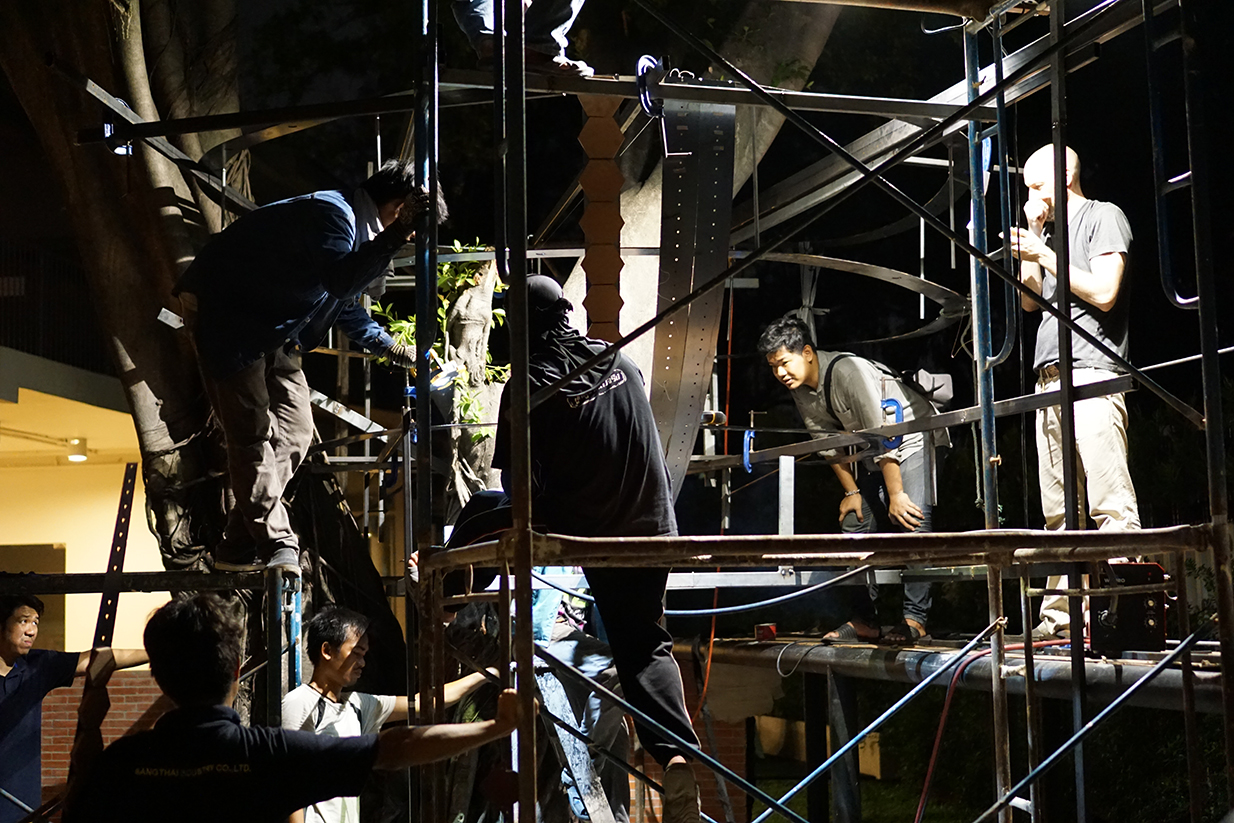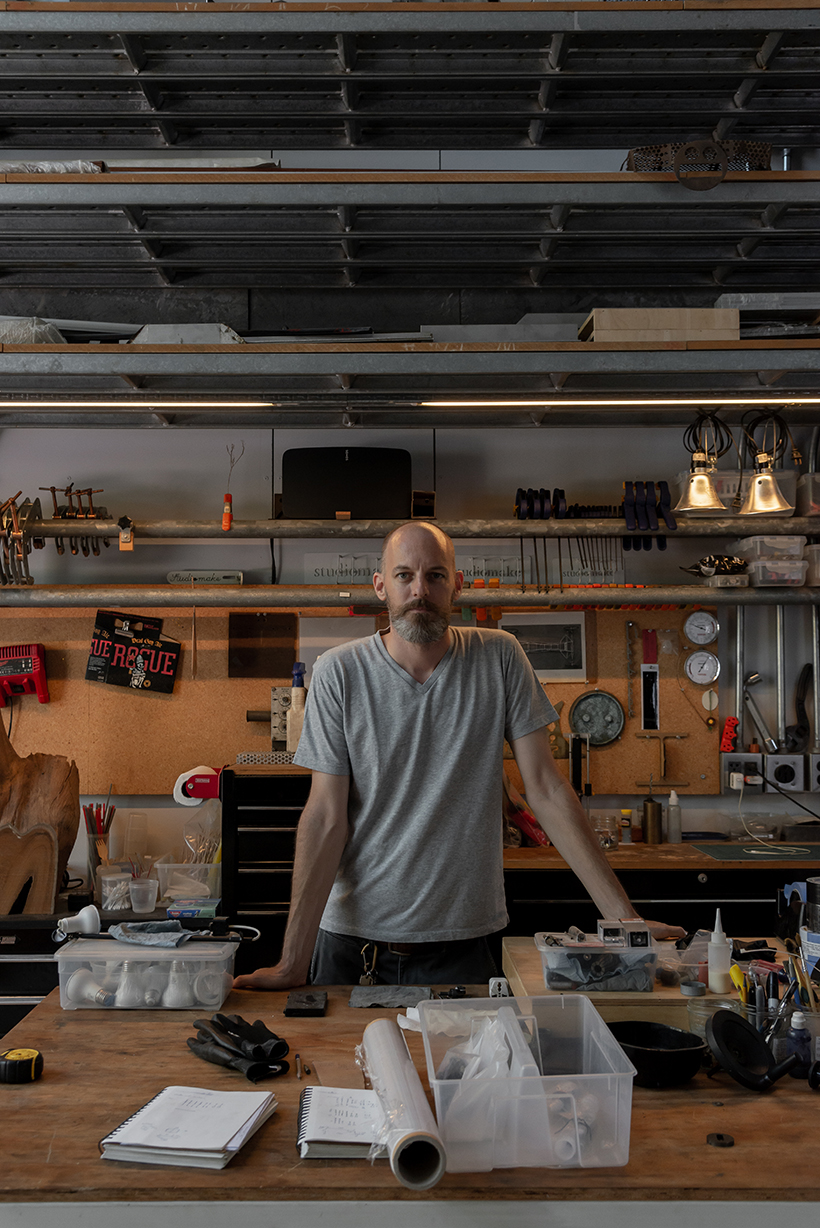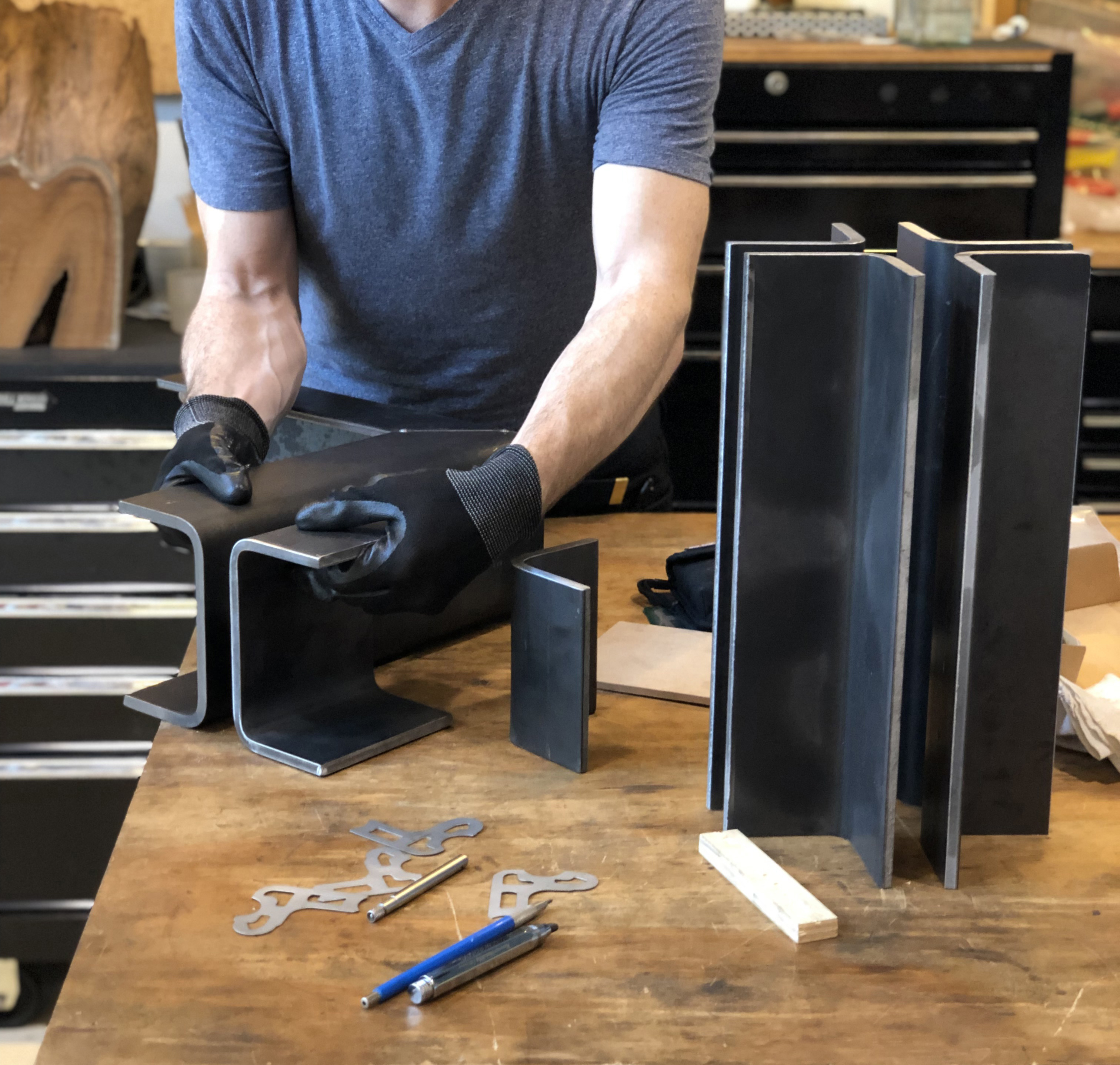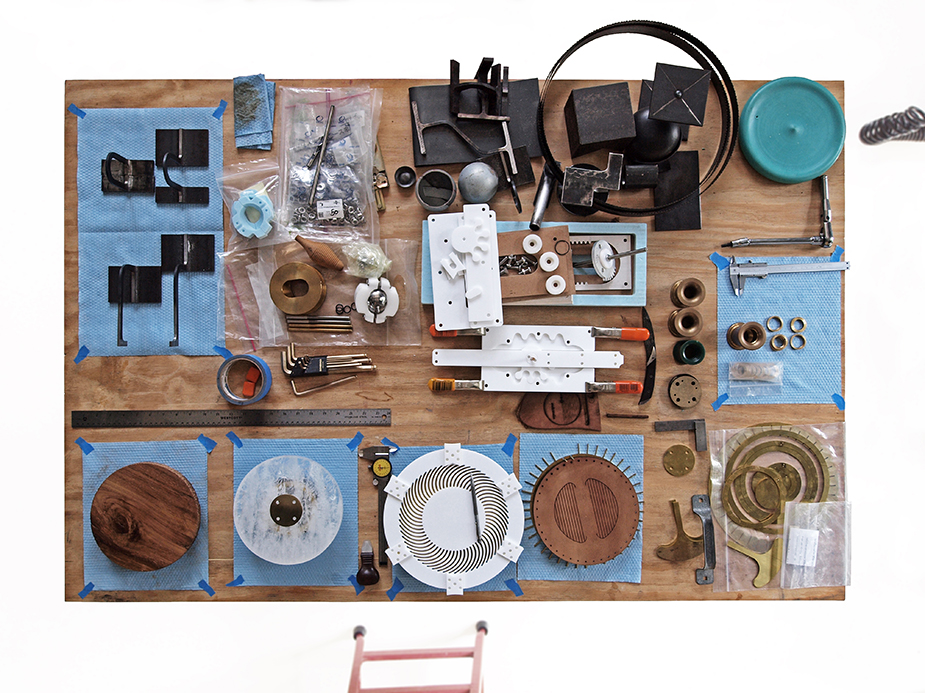WHY ARE HAND, CHANG (CRAFTSMAN IN THAI), AND THE WORD ‘MAKE’ SO IMPORTANT TO THE DESIGN PROCESS OF STUDIOMAKE? LET’S FIND OUT IN THIS CONVERSATION WITH ITS CO-FOUNDER
INTERVIEW BY PAPHOP KERDSUP
PORTRIAT: NAPAT CHARITBUTRA
PHOTO COURTESY OF STUDIOMAKE
(For English, please scroll down)
art4d: ตั้งแต่ที่ได้รู้จักคุณเป็นการส่วนตัวครั้งแรกเมื่อปี 2014 มาจนถึงทุกวันนี้ เรามีความรู้สึกมาตลอดว่าแนวคิดเรื่อง tactility หรือการลงสัมผัสงานที่ทําโดยตรงด้วยมือ เป็นสิ่งที่เราเห็นในการทํางานภายในสตูดิโอมาโดยตลอด คุณคิดว่ามันมีคําที่จะสามารถเอามาใช้อธิบายความเป็น Studiomake นี้ได้ไหม
David Schafer: ผมคิดว่าคงจะอธิบายได้ง่ายที่สุดว่ามันคือ “การเรียนรู้จากการลงมือทํา” หรือการทํางานกับประสบการณ์ที่เรามี เราไม่ได้เข้าใจอะไรต่างๆ จากทฤษฎี แต่เราเรียนรู้จากสิ่งนั้นโดยตรง นี่เป็นวิธีการเรียนรู้ที่เราถนัด ลองนึกถึงตอนเป็นเด็กดู ที่พ่อแม่สั่งไม่ให้คุณจับอะไรบางอย่างเพราะว่ามันร้อน ตอนนั้นคุณเองก็อาจจะเข้าใจมันแค่ในเชิงหลักการ แต่พอคุณได้ลองเอามือไปสัมผัสมัน แล้ว มือคุณไหม้พอง ตอนนั้นแหละที่คุณเริ่มเข้าใจแล้วว่าความหมายของคําว่า “ร้อน” จริงๆ มันเป็นอย่างไร ดังนั้น การทํางานและการทําความเข้าใจ “ความร้อน” ด้วย การดื้อเอามือไปจับ และรอยพองบนมือที่ได้กลับมานั้นจึงเป็นการเรียนรู้ที่ลึกกว่า ผมมองว่าสิ่งนี้ไม่ต่างไปจากการทํางานกับวัสดุ และการออกแบบ ที่เราได้ทําการตั้งสมมติฐาน ลองทํา และมองดูมันล้มเหลวคามือตัวเอง ซึ่งมันเป็นบทเรียนที่ลึกซึ้งกว่า การลงมือทําด้วยมือของคุณเอง ณ สถานการณ์นั้นๆ ในทุกๆ ขั้นตอน เป็นสิ่งที่สําคัญมากสําหรับเรา
art4d: มีอยู่ประโยคหนึ่งใน statement ของ Studiomake ที่ทําให้เราสนใจคือ “การที่เราสามารถสัมผัสได้ถึงน้ําหนักของวัสดุและการเสียดสีของเครื่องมือ ความคิดของเราก็ถูกกระตุ้นด้วยประสบการณ์ที่ได้รับมาจากในมือนั้นเอง” อยากให้ช่วยขยายความตรงคําว่า “ในมือ” นี้สักหน่อย
DS: การทํางานด้วยมือมันสําคัญกับเรามาก ในปัจจุบันมันง่ายมากที่เราจะทําอะไรสักอย่างขึ้นมาด้วยเครื่องมือดิจิตอลและก็ปล่อยให้มันเป็นของนามธรรมไป คือมันมีเส้นแบ่งระหว่างโลกดิจิตอลกับโลกแห่งความจริงอยู่เหมือนกัน แต่พอมันได้อยู่ในมือคุณ ผมคิดว่าคุณจะได้เรียนรู้อะไรมากกว่า แถมมันยังกระตุ้นความคิดสร้างสรรค์ได้มากกว่าด้วย ที่พูดแบบนี้ไม่ได้หมายความว่าเราเป็นพวกต่อต้านคอมพิวเตอร์นะ แต่มันเป็นแค่การวิพากษ์วิจารณ์ถึงสิ่งที่กําลังเกิดขึ้นกับวิชาชีพของเราอยู่ในตอนนี้มากกว่า ผมเข้าใจว่าทําไมเราถึงจําเป็นจะต้องมีออฟฟิศกัน แล้วก็ไม่ได้มองว่าทุกๆ อย่างมันจะต้องทําด้วยมือทั้งหมดแบบที่เราทํากัน แต่ผมคิดว่าการศึกษาทางสถาปัตยกรรมนั้นควรที่จะต้องเน้นเรื่องการลงมือทํางานจริงด้วยมือมากกว่านี้ เพื่อที่คุณจะได้เข้าใจน้ําหนักของวัสดุ ขีดจํากัดของเครื่องมือ และอื่นๆ ซึ่งเป็นความรู้ที่คุณเรียนรู้ได้และมีมันอยู่แล้วในมือของคุณเอง

David Schafer ร่วมก่อตั้ง Studiomake ขึ้นมาในปี 2009 พร้อมกับ Im Sarasalin Schafer
art4d: แสดงว่ามือนั้นกลายมาเป็นเครื่องมือที่ทําให้เราสามารถคิดได้ว่า เราจะสามารถทําอะไรได้มากกว่านี้อีกบ้าง
DS: ผมคิดว่ามือเป็นตัวแปรสําคัญเลยนะ ถ้าคุณไม่เคยลงมือทําด้วยตัวเอง และไม่มีความเข้าใจพื้นฐานเลยว่าการทํางานมันคืออะไร มันผิดพลาดตรงไหน และ ต้องทําอย่างไรคุณถึงจะทํามันสําเร็จ ความเข้าใจของคุณมันจะเป็นแค่อะไรที่ค่อนข้างนามธรรม หรือเป็นแค่ความเข้าใจเชิงทฤษฎีเท่านั้น สําหรับผมหนังสือ “The Thinking Hand” โดย Junani Palasmaa เป็นสิ่งที่พูดถึงแนวคิดนี้ได้ดี เขาอธิบายไว้ชัดเจนที่เดียวว่าทําไมสัมผัสจากมือถึงมีความสําคัญต่อกระบวนการคิดของคน
art4d: ในหนังสือ “The Thinking Hand” มีท่อนหนึ่งที่ Pallasmaa กล่าวว่า “ความคิดและร่างกายนั้นไม่ได้ไม่สัมพันธ์กันหรือแยกออกจากกัน ทว่ามันต่างทํางานร่วมกัน” ช่วยอธิบายแนวคิดตรงจุดนี้เพิ่มเติมหน่อย
DS: จริงๆ แล้วมันมีวลีหนึ่งที่ติดอยู่ในความคิดของผมมาสักพักหนึ่งแล้ว ซึ่งมันเหมือนเป็นส่วนขยายของข้อความในหนังสือของ Pallasmaa ได้พอดี เพื่อนคนหนึ่งของผมจาก Cranbrook Academy of Art มาหาผมแล้วก็เล่าให้ฟังถึงประโยคหนึ่งที่เป็นคําสอนของชนเผ่าหนึ่งในอินโดนีเซียว่า “ความรู้เป็นเพียงแค่เสียงลือ จนกว่ามันจะเข้าไปอยู่ในกล้ามเนื้อ” มันฟังดูแปลกมากๆ โดยเฉพาะความรวบรัดของประโยค แต่ผมค่อนข้างชอบการเลือกใช้คําว่า “เสียงลือ” เพราะมันแฝงนัยในแง่ลบอยู่ในนั้น การที่มันก้ำกึ่งว่าเป็นความจริงหรือไม่จริง แล้วคุณเองก็ไม่สามารถที่จะนิยามว่ามันเป็นความรู้ได้อย่างสะดวกใจ มันมีความเทาๆ อยู่ในนั้น และเป็นสิ่งที่คุณไม่ควรส่งต่อ พูดอีกแบบก็คือ อะไรก็ตามที่เข้ามาในหัวของคุณ ผ่านหูผ่านตา เป็นสิ่งที่คุณไม่สามารถจะเชื่อมั่นได้เต็มที่ จนกว่าคุณจะลงมือทํามันเสียก่อน นอกจากนั้น ความรู้ยังเป็นสิ่งที่ไม่ค่อยน่าเชื่อถือถ้าคุณ ไม่ลงมือทํามันจริงๆ
art4d: ถ้าพูดชื่อ Studiomake ปฏิเสธไม่ได้ที่จะไม่พูดถึงคําว่า “making” จากมุมมองของคุณแล้ว คิดว่า “making” มันคือ คราฟต์หรือเปล่า หรือว่ามันเป็นมากกว่านั้น
DS: เอาจริงว่ามันกลายเป็นเกมหาความหมายคําที่ตรงที่สุดไปทันที ผมคิดว่าตัวเองมีความเข้าใจที่ชัดเจนมากนะ ว่าคราฟต์ งานออกแบบ และศิลปะมันต่างกันอย่างไร แต่ทั้งหมดนี้มันก็เป็นคําใหญ่ที่กว้างมากจนครอบคลุมไปแทบทุกๆ อย่าง ผมคิดว่าความยากของคําว่า “คราฟต์” คือการที่มันไม่ได้เป็นแค่คําคุณศัพท์ที่ใช้อธิบายวิธีการทํางาน แต่มันยังเป็นคํากริยาในตัวมันเองด้วย ผมเดาว่าคําว่าดีไซน์มันก็คงเหมือนกัน สิ่งที่เรากําลังทําอยู่ทุกวันนี้เป็นทักษะฝีมือระดับสูง แต่ผมก็ไม่คิดว่ามันคือคราฟต์เพื่อคราฟต์ หรือเป็นศิลปะเพื่อศิลปะแต่อย่างใดหรอก ไม่ว่ามันจะเป็นเรื่องนามธรรมหรือลึกลับ แค่ไหนก็ตาม คือมันมีเส้นแบ่งระหว่างดีไซน์และศิลปะอยู่ ดังนั้น คําว่า “making” หรือการลงมือทํา สําหรับผมแล้ว มันอาจจะเป็นอะไรที่เกี่ยวข้องกับคราฟต์ งานออกแบบ และศิลปะไปพร้อมๆ กัน Studiomake อาจจะเป็นชื่อที่ดูซื่อๆ แต่ความจริงแล้วมันหมายถึงการจดจ่อกับอะไรบางอย่าง เป้าหมายในการออกแบบนั้นไม่ได้หมายความแค่กระบวนการออกแบบเพียงอย่างเดียว แต่มันจะสําเร็จได้ก็ต่อเมื่อมันถูกสร้างขึ้นมาจริงๆ คล้ายๆ กับเวลาที่คุณเขียนเพลงสักหนึ่งเพลงขึ้นมาแต่ไม่มีใครเคยเล่นมันได้จริงๆ เลย สิ่งนั้นมันจะยังเรียกว่าเพลงได้อยู่หรือเปล่าล่ะ? การมองว่าสถาปัตยกรรมนั้นเป็นบางสิ่งบางอย่างที่ทั้งเริ่มต้นและจบลงบนแผ่นกระดาษหรือคอมพิวเตอร์เป็นสิ่งที่สําคัญสําหรับการพัฒนาความคิดของวิชาชีพ แต่ผมไม่คิดว่ามันจะเป็นสถาปัตยกรรมจนกว่าว่ามันจะถูกสร้างขึ้นจริง
art4d: “ช่าง” เป็นตัวละครหลักในกระบวนการทํางานในสตูดิโอของคุณ ทําไมคุณถึงเลือกที่จะมี “ช่าง” ของตัวเองประจําอยู่ที่ Studiomake
DS: การมีช่างในสตูดิโอเป็นเรื่องสําคัญมากสําหรับการทํางาน ผมมองพวกเขาเป็นผู้ร่วมงานคนหนึ่ง คือมันมีการทําโปรโตไทป์การทดสอบ รวมทั้งการผลิตของต่างๆ หลายประเภทมากที่ Studiomake ซึ่งการมีช่างอยู่ในทีมทําให้เราสามารถสร้างงานออกแบบของเราเองขึ้นมาได้นั้น เป็นสิ่งสําคัญมากทั้งในแง่ของแนวทางการออกแบบหรือทางธุรกิจ ผมไม่ได้จะบอกว่าช่างของพวกเราเป็นนักออกแบบนะ แต่พวกเขามีความยืดหยุ่นและเปิดกว้างต่อแนวคิดใหม่ๆ ได้มากกว่าช่างส่วนใหญ่เลย แล้วเวลาที่เราทํางานกับพวกเขา มันจะไม่ใช่การทํางานแบบ top-down หรือเราไปสั่งให้เขาทําตามความต้องการของเรา ผมคิดว่าการบาลานซ์หรือการทํางานร่วมกันนี้เป็นวิธีการพัฒนาตัวเองรูปแบบหนึ่งที่สําคัญของนักออกแบบเลยล่ะ มันเหมือนกับการรู้ว่าพวกเขาคือมือของคุณ แต่แล้วคุณจะทําให้พวกเขามีส่วนร่วมในการออกแบบมากกว่านั้นได้อย่างไร? คุณจะทําอย่างไรให้เขาเข้าใจความต้องการของคุณ? สิ่งสําคัญไม่ใช่แค่การบอกแนวทาง และสั่งพวกเขาว่าจะต้องทําอย่างไร ประมาณว่า ผมอยากได้ขนาดเท่านี้ ใช้วัสดุนี้ ตัดแบบนี้ แต่คือการทําให้พวกเขาเข้าใจความตั้งใจที่อยู่เบื้องหลังโจทย์และแนวทางเหล่านั้น ไปพร้อมๆ กับการบอกว่าพวกเขาเองก็สามารถแบ่งปันความคิดเห็นกับเราได้ว่าเขาคิดอย่างไร ผมว่านี่คือสิ่งที่สําคัญที่สุด แม้กระทั่งกับตัวผมเอง ผมก็ทํามันมาพักใหญ่แล้ว และถึงแม้จะมีภาพในใจว่ามันควรจะเสร็จออกมาแบบไหน ผมก็ยังพร้อมที่จะเปิดรับฟังความคิดเห็นของพวกเขาอยู่
ผมว่าเราโชคดีที่ได้เจอช่างที่ดี ไม่ใช่แบบที่ทํางานไปวันๆ พอทํางานเสร็จก็กินเบียร์ พวกเขาตั้งใจทํางานออกมาให้สวย.. เสร็จแล้วค่อยกินเบียร์ (หัวเราะ) มันไม่ใช่ว่าพวกเขาทํางานไปเพื่อเงิน ผมว่ามันต่างกัน เพราะพวกเขามีใจรักในสิ่งที่เขาทํา และนั่นเลยทําให้งานมันออกมาดี
art4d: ถ้าต้องแปลคําว่า “ช่าง” เป็นภาษาอังกฤษ คุณจะใช้คําว่าอะไร
DS: มันไม่มีคําไหนเหมาะๆ เลย “ช่างฝีมือ” (craftsman) น่าจะเป็นคําที่ดีที่สุดตอนนี้ แต่ผมก็มองว่าคําๆ นี้มันยังดูทางการไป ส่วนคําว่า “คนงาน” (worker) มันก็ดูลดชั้นกันเกินไป มันไม่มีคําไหนที่อยู่ตรงกลางที่พอดีกับความหมายของคําว่า “ช่าง” เลย
art4d: ใน art4d ฉบับนี้ (art4d No. 267) พวกเราพยายามที่จะมองหานิยามของคําว่า “คราฟต์” ในหลายๆ แง่มุม ด้วยการมองความหมายของมันอย่างหลวมๆ ทั้งในฐานะคํา ความคิด หมวดหมู่ของบางสิ่ง หรือแม้กระทั่งกระบวนการ ทั้งนี้ มีข้อถกเถียงหนึ่งที่ Glenn Adamson เขียนไว้ในหนังสือ Thinking Through Craft ว่า “คราฟต์ดํารงอยู่แต่ในความเคลื่อนไหวของร่างกาย มันเป็นวิธีการทําสิ่งของขึ้นมา ไม่ใช่การแบ่งประเภทที่ใช้จําแนกวัตถุ สถาบัน หรือผู้คน.. คราฟต์ไม่ใช่แบบแผนทํางานที่ถูกกําหนดไว้ชัดเจนตายตัว หากแต่เป็นวิธีคิดผ่านแบบแผนการทํางานทุกรูปแบบ” คุณมีความเห็นอย่างไรกับข้อความนี้บ้าง และคําว่า “คราฟต์” ในนิยามของคุณคืออะไร
DS: ผมว่าผมคงต้องเห็นด้วยกับความคิดของเขา ในสิ่งที่เขาพยายามอธิบายนะ คนเรามักจะคิดว่าคราฟต์หรืองานฝีมือมันเป็นแค่สิ่งของอย่างพวกตะกร้าหรือหม้อไหอะไรต่างๆ แต่ผมมองว่าคราฟต์มันเป็นอะไรที่เกี่ยวโยงอยู่กับทักษะฝีมือของช่างมากกว่า มันเป็นเรื่องการลงมือทําอะไรบางอย่างให้เกิดขึ้น ผมเองก็ชอบคิดว่าการเขียนแบบด้วย AutoCAD หรือแม้แต่ตู้เย็นที่บ้านผมเองมันก็มีทักษะฝีมือนะ หรือการที่ตัวผมทําสลัดออกมาได้อร่อย นี่ก็เรียกว่ามีฝีมือเหมือนกัน เพราะฉะนั้น เราอาจจะบอกได้ว่าคราฟต์มันเป็นเรื่องของการที่คุณมีส่วนร่วมกับโลกทางกายอย่างไร แล้วคุณสามารถปรับเปลี่ยนหรือดัดแปลงโลกใบนั้นอย่างไร แม้แต่ AutoCAD เองมันก็มีระดับของความเป็นกายภาพอยู่ คิดว่านี่น่าจะเป็นนิยามที่กว้างที่สุดที่ผมจะนึกได้แล้วในการทํางานของผมเอง การแสวงหาสิ่งที่เรียกว่าคราฟต์สําหรับเรา มันคือการได้ลงมือทําสิ่งของและผลงานสถาปัตยกรรมที่ผ่านการขัดเกลาด้วยทักษะฝีมือเป็นอย่างดี ไม่ว่าจะผ่านรายละเอียดในการออกแบบหรือการจัดวางพื้นที่ใช้สอย และนําเสนอมันให้ผู้คนที่คู่ควร คือถ้าเราทํามันออกมาดี มันก็จะอยู่กับเราได้นานขึ้น ถ้าเราทํามันออกมาอย่างพิถีพิถัน มันก็จะสามารถถูกนําไปประยุกต์ใช้และเป็นประโยชน์ได้ในระยะเวลาที่นานขึ้น งานคราฟต์ที่ดีมันเป็นความยั่งยืนรูปแบบหนึ่งอยู่แล้วสําหรับผม และมันก็เป็นสิ่งที่ใช้บอกกับลูกค้าของเราอยู่เสมอด้วย ของรอบตัวเราโดยส่วนใหญ่มันยังขาดทักษะฝีมืออยู่ ซึ่งผมก็มักจะมองว่าสิ่งที่ Studiomake เรากําลังทําอยู่นั้น บางทีมันอาจจะเป็นการโต้ตอบกับรูปแบบของการบริโภคที่เห็นชัดเจนกันอยู่ทุกวันนี้ ซึ่งมันเป็นการบริโภควัตถุแบบใช้ครั้งเดียวแล้วทิ้งที่มีความเฉพาะที่มาก
art4d: เวลาที่เราพูดถึงคําว่า “คราฟต์” โดยเฉพาะอย่างยิ่งสําหรับคนไทยเอง มันอดไม่ได้ที่พวกเราจะพูดถึงมันบนขอบเขตของความเป็น “งานฝีมือ” (handicraft) อยู่โดยตลอด แต่กระนั้น ด้วยการมาถึงเทคโนโลยีใหม่ๆ ที่ถูกพัฒนาไปอย่างรวดเร็วมากในปัจจุบัน สิ่งที่เรียกว่า “ดิจิตอลคราฟต์” รูปแบบใหม่ๆ ที่ใช้ประโยชน์จากความก้าวหน้าของเทคโนโลยี การพิมพ์และการสแกนสามมิติ ปัญญาประดิษฐ์ หรือแม้แต่เทคโนโลยีการเรียนรู้เชิงลึกนั้นเริ่มปรากฏให้เห็นมากขึ้น ซึ่งมันต่างก็เอื้อให้เราสามารถทําอะไรต่างๆ ตามความต้องการได้อย่างอิสระและยืดหยุ่นมากกว่าเดิม ตรงนี้เลยอยากจะถามว่าคุณมีความเห็นอย่างไรกับดิจิตอลคราฟต์บ้าง
DS: นั่นเป็นเหตุผลว่าทําไมผมถึงเลี่ยงที่จะใช้คําว่า “คราฟต์” มันค่อนข้างยากอยู่เหมือนกันเวลาที่เราพยายามจะแยกแยะความแตกต่างระหว่างสิ่งที่ทําด้วยมือ กับสิ่งที่ทําด้วยเครื่องจักร จริงๆ มีหนังสือเล่มหนึ่งที่ David Pye เขียน ชื่อว่า “The Nature of Art and Workmanship ซึ่งถกประเด็นในเรื่องของความเปรียบต่างระหว่างสิ่งที่เขาเรียกว่า การทํางานฝีมือบนความแน่นอน (mass production) และการทํางานฝีมือบนความเสี่ยง (craft)
กลับมาที่เรื่องของดิจิตอลคราฟต์หรือการประดิษฐ์สร้างในแบบดิจิตอลอีกที ผมไม่คิดว่ามันจะเป็นสิ่งที่ตรงกันข้ามอย่างสิ้นเชิงกับงานฝีมือนะ สําหรับผมแล้ว ยังไงงานฝีมือก็จะยังมีที่ทางของมันอยู่เสมอ มันเป็นสิ่งที่วิวัฒน์ไปพร้อมๆ กับสังคม ในฐานะส่วนหนึ่งของชีวิตที่ทุกวันนี้เริ่มจะมีความอัตโนมัติมากขึ้นเรื่อยๆ ซึ่งมันก็ไม่ได้เป็นสิ่งที่แย่ตรงไหนเลย ถ้าเกิดว่าเราทุกคนจะหันไปใช้ระบบ EasyPass กันหมด ผมคิดว่าเจ้าหน้าที่ประจําด่านเก็บเงินบนทางด่วนที่ตกงานก็จะสามารถหางานหรือสิ่งที่จะทําได้ตรงกับทักษะที่พวกเขามีในที่อื่นๆ หรือในรูปแบบอื่นๆ ได้อยู่ดี ดังนั้น แค่เพียงเพราะว่าเราใช้เครื่องเลเซอร์คัท เครื่อง CNC หรือเครื่องพิมพ์สามมิติ ก็ไม่ได้หมายความว่าช่างฝีมือที่สามารถแกะสลักของขึ้นจากไม้ด้วยมือตัวเองได้จะไม่เป็นที่ต้องการอีกต่อไปแล้วนี่ เราเองก็ทําแบบนี้ที่สตูดิโอเหมือนกัน คือถึงแม้ว่าเราจะใช้เครื่อง CNC ในการทําของอะไรบางอย่างขึ้นมาอยู่บ่อยๆ แต่เราก็มีของที่ยังต้องการการลงมือแกะมันขึ้นมาจากไม้ด้วยอยู่ดี
ถ้าคราฟต์มันจะตาย ก็แสดงว่ามันตายด้วยเหตุผลบางอย่าง มันเป็นเรื่องดีที่รัฐบาลหรือองค์กรที่ไม่แสวงหาผลกําไรต่างๆ จะเข้ามาช่วยอนุรักษ์งานฝีมือบางอย่าง แต่ผมไม่คิดว่าเราควรที่จะถึงขนาดมีการบังคับใช้กฎหมายเพื่อป้องกันไม่ให้มันหายไป มันเป็นเรื่องของการหาวิธีที่จะทําให้มันสามารถวิวัฒน์ไปได้แตกต่างจากเดิมอย่างไรมากกว่า ผมไม่รู้เหมือนกันนะว่านี่มันตอบคําถามของคุณหรือเปล่า แต่ผมไม่คิดว่ามันเป็นเรื่องเลวร้ายอะไรเลยถ้าของบางอย่างจะถูกทําขึ้นมาด้วยเครื่องจักรหรือด้วยระบบดิจิตอล จริงๆ มันยิ่งช่วยทําให้งานฝีมือมันมีความพิเศษมากขึ้นด้วยซ้ำไป

Studiomake และบรรดาช่าง ที่กำลังง่วนอยู่กับโครงการ Raintree / Studiomake crews and Changs working on the Raintree project
art4d: จนถึงตอนนี้ เราเข้าใจกันว่าคราฟต์เป็นสิ่งที่ถูกรับรู้และสร้างความชํานาญได้ด้วยมือ ไม่ใช่ด้วยความคิด มันเป็นอะไรที่ประกอบไปด้วยการกระทําในเชิงกายภาพมากกว่าความคิดในเชิงนามธรรม แต่เราจะสามารถคิดกับคราฟต์ในฐานะความคิดเชิงนามธรรมด้วยได้บ้างหรือเปล่า
DS: ผมว่ามันก็มีงานคราฟต์อย่างพวกบทกวีด้วยนะ คือคุณจะมองว่าวิธีการสื่อสารความคิดที่มีความซับซ้อนออกมา ผ่านการเลือกใช้คําเพียงไม่กี่คํามันเป็นคราฟต์ด้วยก็ได้ สําหรับผมแล้วใครก็ตามที่พูดประโยค “ความรู้เป็นเพียงแค่เสียงลือ จนกว่ามันจะเข้าไปอยู่ในกล้ามเนื้อ” นี้ออกมา แสดงว่าเขาก็ต้องมีทักษะฝีมืออยู่ในความคิดของเขาระดับหนึ่งเลย ผมคิดว่าคําพูดที่คุณอ้างอิงมาที่ว่าคราฟต์นั้นเกี่ยวพันอยู่กับการกระทํามันใช่เลยล่ะ แต่ไม่ได้หมายความว่ามันต้องเป็นการกระทําในเชิงกายภาพเสมอไปนี่ มันน่าจะเป็นการยืนยันที่จะทําบางสิ่งบางอย่างให้ดีกว่าเดิมมากกว่า ซึ่งบางที่อาจจะด้วยการทําอะไรสักอย่างอย่างสุดความสามารถก็ได้ ไม่ว่าจะเป็นการคราฟต์ประโยคสักประโยคออกมา หรือการคราฟต์งานไม้หรือเครื่องเบญจรงค์สักชิ้นขึ้นมา
อย่างที่คุณว่า ผมคิดว่างานฝีมือมันก็เป็นเรื่องหนึ่ง แต่มันก็น่าสนใจเหมือนกันว่าในหลายๆ มุมเลยที่งานฝีมือค่อยๆ ออกห่างจากความคิดสร้างสรรค์ขึ้นเรื่อยๆ กระบวนการผลิตงานฝีมือบางประเภทนั้นค่อนข้างจะลดทอนความเป็นมนุษย์ลงไปด้วยซ้ํา อย่างเครื่องเบญจรงค์เองก็เป็นอะไรที่พวกเราได้เข้าไปมีปฏิสัมพันธ์ด้วยมากเป็นพิเศษ คือตัวคนที่เข้าไปเกี่ยวข้องในกระบวนการผลิตนั้นไม่ต่างไปจากเครื่องจักรเลย พวกเขาจะนั่งอยู่ในห้องเล็กๆ แล้วก็ทําอะไรซ้ําๆ ไปเรื่อยๆ นับครั้งไม่ถ้วน ซึ่งนั่นมันเป็นเรื่องที่แย่มากๆ พอถึงจุดหนึ่งถ้าคุณหัวการค้ามากเกินไป อย่างการพยายามสต็อกของบนชั้นในร้านค้าปลอดภาษีด้วยงานฝีมือที่มันดูไร้ที่ติมากๆ คราฟต์มันก็ไม่ใช่สิ่งที่ทําให้รู้สึกดีอีกต่อไปแล้ว เพราะฉะนั้น ผมมองว่าบริบทนั้นเป็นสิ่งสําคัญ ในการที่จะทําความเข้าใจว่าแท้จริงแล้วสิ่งที่คุยกันอยู่นี้มันเป็นงานฝีมือในด้านบวก หรือเป็นแค่การใช้แรงงานเท่านั้น
art4d: คุณคิดว่ามันมีสิ่งที่เรียกว่า “ไม่ใช่คราฟต์” (non-craft) อยู่ไหม
DS: ผมว่ามันมีสิ่งที่เรียกว่าการขาดทักษะฝีมืออยู่ แต่ผมนึกไม่ออกเลยจริงๆ ว่าจะมีอะไรที่มันเป็นไม่ใช่คราฟต์ได้ นอกไปจากสิ่งที่เราเองควบคุมมันไม่ได้ ในมุมมองของผมนะ ถ้าเกิดว่าคุณพยายามที่จะควบคุมอะไรสักอย่างหนึ่งแล้วล่ะก็ มันย่อมเปิดโอกาสให้คราฟต์เกิดขึ้นมาอยู่แล้ว ถูกไหม คําถามนี้น่าสนใจเหมือนกัน ไม่รู้สิ ความหมายของคําว่าคราฟต์หรืองานฝีมือในพจนานุกรมมันบอกไว้อย่างไรบ้างล่ะ ถ้าเป็นคํานาม มันหมายถึงกิจกรรมที่ต้องใช้ทักษะในการทําของบางอย่างด้วยมือเข้ามาเกี่ยวข้องด้วย ซึ่งตรงนี้ผมเองก็ไม่ได้เห็นด้วยเสียทีเดียว มันอาจจะเป็นความหมายตามพจนานุกรมที่คนนิยมใช้กันโดยทั่วไป ทว่าผมมองมันเป็นคํากริยามากกว่า คือการบริหารทักษะในการทําบางสิ่งบางอย่าง ซึ่งความหมายนี้มันสามารถถูกนําไปประยุกต์เข้ากับอะไรก็ได้ อย่างคนขับรถแย่ๆ เองก็แสดงความขาดทักษะฝีมือในการใช้รถของพวกเขาเอง เป็นต้น
การเข้าใจของทุกอย่างนั้นจําเป็นจะต้องมีระดับของความคราฟต์อยู่ในนั้น มันเป็นวิธีการที่เราใช้มองโลกใบนี้ที่สําคัญเลย เหมือนกับการเป็นนักออกแบบนั่นแหละ การมีความปรารถนาที่จะทํางานคราฟต์มันไม่ใช่อะไรที่คุณจะเปิดหรือปิดมันได้ เพราะฉะนั้นผมเลยไม่รู้จริงๆ ว่าจะมีอะไรที่จะถูกยอมรับได้ว่าไม่ได้ถูกคราฟต์ สําหรับผมแล้ว คราฟต์มันเป็นโหมดพื้นฐาน เป็นของที่ถูกทําขึ้นมาด้วยการ พินิจพิจารณา ถ้าอะไรก็ตามที่ถูกทําขึ้นนั้นไร้ซึ่งการพิจารณาแล้วล่ะก็ แสดงว่ามันจะต้องเป็นผลลบหรือข้อผิดพลาดแน่ๆ ถูกไหม คือผมว่ามันไม่มีอะไรที่จะไม่ใช่คราฟต์ได้เลย นอกจากการหายใจ

art4d: Since I personally knew you back in 2014 up until today, I always feel that the idea of ‘tactility,’ being able to touch or get a hand on something, has always been around in the studio. Do you consider that there is any terminology that sort of describes the ‘Studiomake-ness’?
David Schafer: I think the easiest way to describe it is as ‘empirical learning’; an ‘empirical way of working,’ we are not necessarily understanding things in theory but in actuality. It’s how we learn best. As a kid, when your parents tell you not to touch something because it’s hot, you understand it just in theory. But until you touch it and burn the shit out of your hand, you start to understand that it is hot. So, the way of working and understanding that something is hot by touching it and burning yourself is a deeper lesson and that same thing works with material and design—having an idea and watching it fail in your own hands is a much deeper lesson. This sort of hands-on, immediate, real-time, full-scale way of working is, thus, really important to us.
art4d: There is this one sentence in Studiomake’s statement which really sparks my interest that I would like to recite: “Being able to experience the weight of material and the friction of tools, our ideas are catalyzed by empirical knowledge derived in-hand.” Can you elaborate on your definition of the word ‘in-hand’?
DS: Literally working ‘in-hand’ is really important for us, nowadays it’s so easy to do something digitally and remain abstract, there is a separation between the digital world and the real world. But when it’s physically in your hands, I think you can learn more, and it allows us to be more creative. It’s not that we are anti-computer, but I would say that it’s kind of a general critique of the current state of the profession. I understand why there has to be offices and I also don’t think every practice needs to be as hands-on as we are. But I do think architectural education should be more hands-on so that you are able to understand the weight of materials, the friction of tools, etc.— the kind of knowledge that’s in your hands.

David Schafer co-founder Studiomake with Im Sarasalin Schafer in 2009
art4d: So, the hand becomes an instrument that gives us the ability to think about how we can do something further.
DS: I think it’s a very important input variable, right? If you haven’t touched something yourself and don’t have some basic understanding of how things feel, how things fail or succeed with your own hands, your understanding of it will still be abstract and remain theoretical. To me, Junani Pallasmaa’s ‘The Thinking Hand’ is kind of the seminal piece of literature on that idea and I think he describes it so clearly, the sense of touch is a really important part of the thinking process.
art4d: In Pallasmaa’s ‘The Thinking Hand,’ he argues that the body and the mind are neither unrelated nor separated entities but rather integrated. Can we discuss about his idea a bit more?
DS: You know, there actually is a phrase that’s been in my thoughts recently which is really kind of an extension of Pallasmaa’s book. A friend of mine from Cranbrook Academy of Art came to visit and related this amazing quote which apparently is a saying of a native tribe from Indonesia: “Knowledge is rumor until it enters the muscle.” It’s really an odd, spare arrangement of words and I like the choice of the word ‘rumor’ because it has this kind of negative connotation, that something may or may not be true and you are not currently qualified to possess this knowledge. It’s slightly scandalous and you shouldn’t really be passing it. In other words, something that comes into your head through your ears and through your eyes is not really solidified until you take action on it, and further, knowing something is irrelevant if you don’t act.
art4d: Speaking about Studiomake, it is undeniable not to mention the word ‘making.’ From your perspective, is ‘making’ craft or it is more in that?
DS: Well, it quickly gets into a semantics game— juggling the precise meaning of words. I do understand the difference between craft and design and art but those are big words that can encapsulate a lot of things. I think the difficult thing behind the word ‘craft’ is that it’s not only an adjective for a way of working but also a verb. I guess design is the same thing. What we do here has high level of craftsmanship, but I don’t think it is craft per se in the same way that I don’t think it is art, no matter how abstract or esoteric it is. There’s a distinction between design and art. So, the word ‘making’ to me is perhaps what links craft, design, and art together. Studiomake might be a dumb name, but it’s really about keeping the focus. That the intent of design is not just about the act of designing, it’s incomplete until it is made. Just like you can write music but if nobody ever plays it, then what is it? So, considering architecture as something that originates and ends on paper or the computer is important for the discourse of the profession, but I don’t think it’s really architecture until it’s built.
art4d: A ‘Chang’ or, I would say, a craftsman is one of the key personnel who plays an important part in your studio. Can we talk about your decision of having your own Chang at Studiomake?
DS: Having a Chang here is critical for us and I look at them as a collaborator as well. There are many kinds of prototyping and testing of things as well as productions at Studiomake. Having them and the ability to make our own designs are really important both as a design and business approach. I wouldn’t say that our Changs are designers, but they are more open and flexible to new ideas than most. And when working with them, it’s not a top-down structure. I think this kind of delicate balance or collaboration is really a critical part of developing oneself as a designer. It’s like knowing that they are your hands. But how do you get them involved? How do you get them to understand your intent? What’s important is to not only convey the facts or communicate a set of instructions—like I want this dimension, use this material, or cut it this way—but to get them to understand the intent behind those instructions as well so that they can give you feedback. I think that’s the important thing. Even for me, I’ve been doing this for a while. Even though I have a way in which I want things to be done or think things should be done, I’m always open to their feedback. And I think we’ve been fortunate to find Changs that aren’t just executing the work and drinking beer. But they’re making something beautiful… and then drinking beer. [laughter] It’s not that they just want to do things and get paid. I think that’s the difference. It’s like they have a passion, and if they are passionate about the work, then it’s all good.
art4d: So, if you were to translate ‘Chang’ in English, what would be the word?
DS: There’s no good word. ‘Craftsman’ would be the best word, I guess. But I feel like ‘craftsman’ is still too formal and ‘worker’ is also too low. There’s not really a proper word in English that goes in the middle for Chang.

The prototyping process behind the different design projects
art4d: As we are in search of the multifaceted notions of ‘craft’ in this issue of art4d (No.267)—trying to look at it loosely as a word, an idea, a category of something, or even a process; there is an argument in Glenn Adamson’s ‘Thinking Through Craft’ that writes: “craft only exists in motion. It is a way of doing things, not a classification of objects, institutions, or people… Craft is not a defined practice but a way of thinking through practices of all kinds.” What do you think about his statement? And what is your definition of craft?
DS: I guess I would agree with him, with what he’s trying to clarify. People think craft generally stands for making objects like baskets or pots. But I think of craft as something that relates to craftsmanship. It’s about making things. I’d like to think that AutoCAD drawings or even my refrigerator has good craftsmanship or that I make a good salad, and that’s good craftsmanship too. So, I think we could say it’s about how you engage with the physical world, how you either manipulate or modify that world. Even AutoCAD has a degree of physicality to it. I guess that’s the broadest definition I could come up with. In my practice, my pursuit of craft has to do with making well-crafted objects and architecture, whether through their details or space planning, and presenting them to people who are well deserving. It’s like if we do it right, then it’s going to last longer. If we do it in a smart and considerate way, then it can adapt and be useful for a longer time. To me, good craft is a form of sustainability and it’s something I always talk to my clients about. There’s a lack of craftsmanship in most of the objects around us and I’d like to think that what Studiomake is doing is maybe a counterpoint to this kind of conspicuous consumption, the endemic consumption of disposable objects.
art4d: When it comes to discussing about craft, especially for the Thais, we often call upon just only the border of ‘handicraft.’ However, with the advent of new technology developed at a very fast pace nowadays, the new form of ‘digital craft’ which harnesses the advancement of 3D printing and scanning, AI, or deep learning technology has emerged, allowing us to do or customize things more flexibly. What is your opinion on digital craft?
DS: That’s why I generally avoid using the word ‘craft’, it gets slippery when we try to distinguish between the hand-made and the machine-made. There’s a book written by David Pye titled ‘The Nature of Art and Workmanship’ that really discusses this distinction between what he calls the workmanship of certainty (mass production) versus the workmanship of risk (craft). Getting back to the digital craft or digital fabrication, I don’t think it is an antithesis or is against handicraft. For me, handicraft will always have a place. It’s one of those things that evolves with society, as parts of life become more and more automated, it’s not necessarily a bad thing. If everybody were to start using EasyPass, I assume that all the tollbooth workers that were out of a job would find use for their talents somewhere else in some other capacity. So, just because we have laser cutters, CNCs or 3D printers, it doesn’t mean that there is no need for people to carve things out of wood by hand. We do that sometimes in our studio. Although we have a CNC and are usually using it to make something, we also have things that are hand-carved out of wood.
If craft were to die, then it’s dying for a reason. It’s great that governments or nonprofit agencies preserve certain crafts but I don’t think we should put in laws to prevent them from crashing or finding its end. It’s about how we could find the way for it to evolve differently. I don’t know if that really answers your question, but I don’t think that it’s a bad thing that certain things can be done mechanically or digitally. That actually makes the handmade stuff more special in many ways.

กระบวนการสร้างสรรค์โปรโตไทป์ของโครงการออกแบบต่างๆ
art4d: To this extent, I think we realize that ‘craft’ is something mastered in the hands, not in the mind, something consisting of physical actions, rather than abstract ideas. But can we really think of ‘craft’ as an abstract idea as well?
DS: I mean, there’s a craft like poetry. I think you could consider that craft as well; how you communicate these really complex thoughts in a delicate arrangement of, or a spare use of words. For me, whoever said a well-crafted sentence like “knowledge is rumor until it enters the muscle” really showed a degree of craftsmanship in their thoughts. I think your quote is right that craft involves an action, but it’s not necessarily physical action. It’s an assertion to do something better, perhaps by doing something the best you can whether it is crafting a sentence or crafting a piece of wood or Benjarong ceramics.
I think handicrafts like you said is one thing but it’s interesting that handicrafts, in many ways, are becoming far from creative. The process of making some of them is actually quite dehumanizing, Benjarong ceramics being one that we’ve specifically interacted with. The people who are involved in the production process are basically machines per se. They would sit in these tiny little rooms and do exactly the same thing over and over again and that’s kind of shitty in a way. At that moment when you have this kind of intense commercial focus, like stocking the shelves of duty-free with flawlessly crafted products, then craft doesn’t feel good anymore. So, I think context is important to understanding if it’s really craft in a positive sense or if it’s simply forced labor.
art4d: Do you think that there is such thing as ‘non-craft’?
DS: I would say that there is a lack of craftsmanship, but I can’t think of anything that is non-craft, other than things that we can’t really control. From my view, once you try to control something, then there is an opportunity for craft, right? It’s an interesting question in the sense. I don’t know. What is the dictionary definition of craft? As a noun, it’s an activity involving skill in making things by hand, which I don’t really agree with that. That might be the dictionary definition which is commonly used but I would think of it as a verb which means to exercise skill in making something. And this can really be applied to anything, like bad drivers are exhibiting a lack of craft in making use of their cars.
Understanding everything requires a degree of craft. It’s an important way of looking at the world. Like being a designer, having a desire to craft, it is not something you can turn on and off. So, I don’t know what would be acceptable to not be crafted. To me, craft would be default; something done with consideration. If something is done without consideration, it must be negative or a failure? I just don’t know what acceptable non-craft would be, other than just simply breathing.





